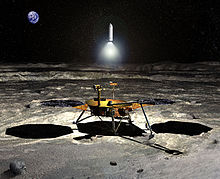|
MoonRise
MoonRise is a robotic mission concept to the south pole of the Moon. It was proposed in 2017 for NASA's New Frontiers program mission 4, but it was not selected. If funded and launched by another NASA opportunity, it would focus on the giant South Pole–Aitken basin (SPA basin) on the far side of the Moon between the Moon's South Pole and Aitken Crater, 16° south of the Moon's equator. This basin measures nearly 2,500 kilometres (1,600 mi) in diameter and 12 kilometres (7.5 mi) in depth. This region is the oldest and deepest observable impact basin on the Moon and provides a window into the deep crust of the Moon and its history as a result. The basin is also among the largest recognized impact structures in the Solar System.[1] MoonRise was not selected for the third New Frontiers program mission 3, losing out to the OSIRIS-REx asteroid sample return mission,[2] and it lost again in the 2017 competition for New Frontiers program mission 4.[3] Science objectives  MoonRise has the following objectives:[1]
Future prospectsMoonRise received Phase A funding out of the New Frontiers program.[4] The study was one of three concepts to get US$3.3 million funding in 2010 to further develop the mission for the final selection, which was a US$650 million mission to launch in the late 2010s.[5] The three semi-finalists were MoonRise, the OSIRIS-REx sample return mission, and the Venus In Situ Explorer mission.[5] Although MoonRise was passed over in favor of OSIRIS-REx in the 2011 selection, a South Pole–Aitken basin sample return mission remains part of the 2013–2022 Planetary Science Decadal Survey's recommendation for potential New Frontiers missions,[6] and NASA's Planetary Science Division has expressed support for the Decadal Survey's recommendations.[7] See also
References
External links
|
||||||||

